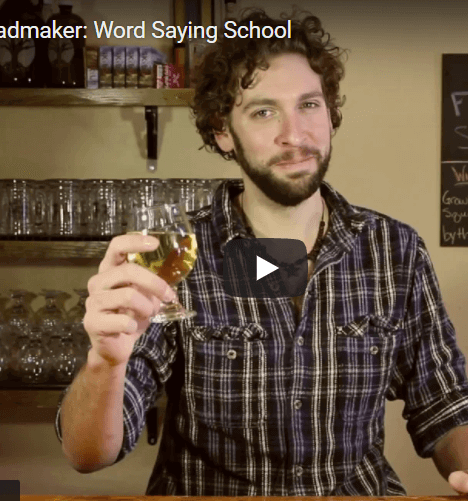In which Ricky the Meadmaker answers questions about a yeasty taste in mead, the differences between Wyeast nutrient and Fermaid, what he would have done differently if he knew then what he knows now, and more!
Further Reading:
Wyeast Laboratories
How We Brew Everything We Brew
TRANSCRIPT
They say you can tell a lot about a man by the company he keeps. I hang out with lukewarm coffee and a travel mug from the late 80s. Make of that what you will.
Welcome to Ask the Meadmaker, where I, Ricky the Meadmaker, answer your questions about mead making, mead drinking, mead brewing, and really any question you're willing to send to me.
Our first question this week comes from Ellie, who has been making craft mead at home. She came in a little while ago and we chatted about my tips and techniques, and she's trying to use them for her home brewing. The problem is making meads like mine, craft meads, things with bubbles, she's getting in 6-8 weeks, something drinkable, but super yeasty. What is she doing wrong? Should she step back on her yeast nutrient? Should she use less yeast? The answer is paradoxically, probably not. what people think of as a yeast flavor is all flavors from the fermentation of the yeast, meaning the healthier the yeast, the more you have of it, the less you taste. So, if what you're really tasting is that sort of bready thing from the yeast, adding more, not less yeast is usually the solution, though not always. And yes, you could maybe back off on the yeast nutrient a little bit, but that probably won't make that much of a difference.
Our next question comes from Nate, and it's about beard oil and my thoughts on it. And I think that beard oil is a scam. Do you know that people pay over $400 an ounce for the oil created by my beard? It's just ridiculous. All it does is maybe prolong your longevity by 5-20 years.
Here's a great and confusing question from Nick. Nick says, "Hey, Ricky, I'm fairly young... 20. But for the longest time, I've wanted to make different types of alcohol. I'm likewise fairly inexperienced, but I have a pretty decent advertising idea. And I'm working on the product when I have the money. Any advice on how I should go about achieving this dream of mine? Given how vague your dream is, no. Keep practicing. Get more money. It's a great question. Just a little open-ended.
Our next question comes from Mark, and unlike the last one is very specific. I regularly recommend using yeast nutrient from Wyeast and I've said this before, I am not a shill for their company. I have given them a lot of money and they've never given any to me. I just use it here at our facility so I know it very well. There are two major types. Beer yeast nutrient and wine yeast nutrient, both sold by Wyeast. And he wants to know, what is the difference? And how do they relate to Fermaid K? The answer is, I don't know. But I do know this the people at Wyeast laboratories are unbelievably helpful and they have a new website that has tons of information on it. I have gone down the rabbit hole of the Wyeast website on probably five or six occasions and lost like half a day. So, rather than my telling you the difference, which I don't know, I would recommend checking out their website and seeing if you can figure out what it is. I do know that it's a proprietary recipe. So, you may not be able to find out that much. As for Fermaid K, very popular in the brewing world, I found that it causes certain problems in my experience with a nitrogen burn taste for the yeast. That might have just been that I was an inexperienced for at the time. What I have found, and this is anecdotal, that people who use Wyeast nutrient, which is a very mineral-heavy version of nutrient, tend to get really good mouthfeel and really quick turnaround. People with Fermaid K tend to get hot and yeasty flavors in their fermentation. But as I said, anecdotal, and I have no interest in either of these companies other than the fact that we use Wyeast nutrient here.
Our last question this week comes from Sage Price from Hawaii. And Sage Price wants to know if I had to do it all over again, what would I do differently? And this is a big question. We talk about it all the time, Kelly the boss and I, if we knew then what we know now, what would we have done differently? And the answer is a huge amount. Probably including never having started a meadery. When I think back on the days covered in propylene glycol, and the shattered glass in the early days of bottling and that the 13, 14-hour days, sweeping mead down a floor drain, I think I would never, ever wish that on anybody. Thank goodness I didn't know back then what I know now.
That's our last question this week. I just need to send it over to Ricky with our Word of the Week. Ricky. Thank you, Ricky. We're drinking the same thing today. That's super weird. This week's word is acetyl aldehyde. It's a lot of fun to say, but not great in your final fermented beverage. Acetyl aldehyde is a compound that tastes like green apples, and it's considered an off-flavor in brewing. The funny thing about it is every single alcohol has acetyl aldehyde. And this is why. Acetyl aldehyde is part of the metabolic process that turns sugar into ethanol. So, at some stage of the fermentation, there will be acetyl aldehyde. But the problem is, what if it doesn't go away? The reason for this, the reason it might not go away, is because your yeast is insufficient. It fails you. It's still cold. You don't have enough of it. It doesn't finish its fermentation. So, it leaves some of the acetyl aldehyde behind. This is a pretty easy problem to solve. And I talked about it all the time on this show. More yeast.
That's our Word of the Week. Acetyl aldehyde. Great word. Use it in conversation and keep sending your questions. I'll get to them as soon as possible. Cheers.




